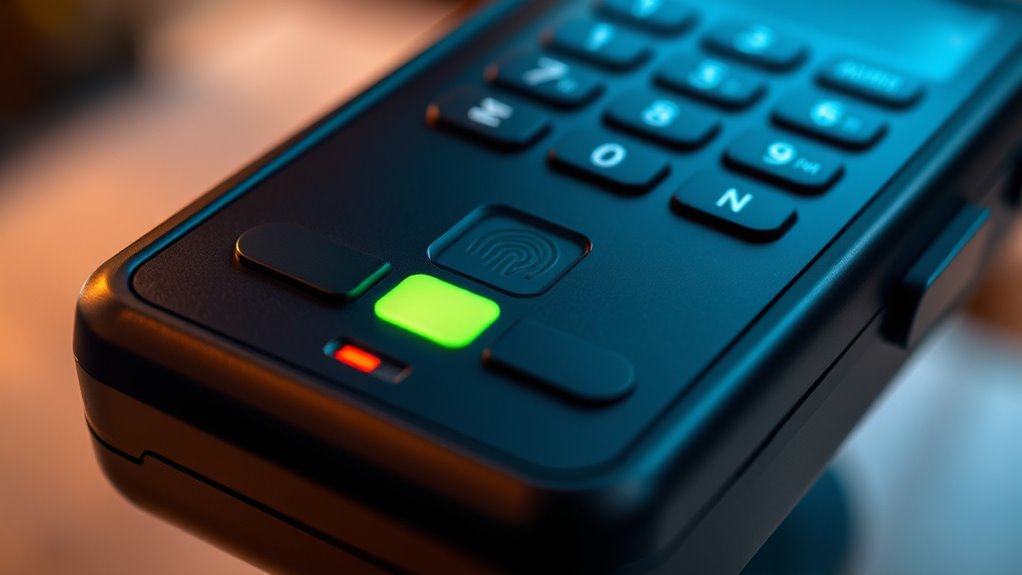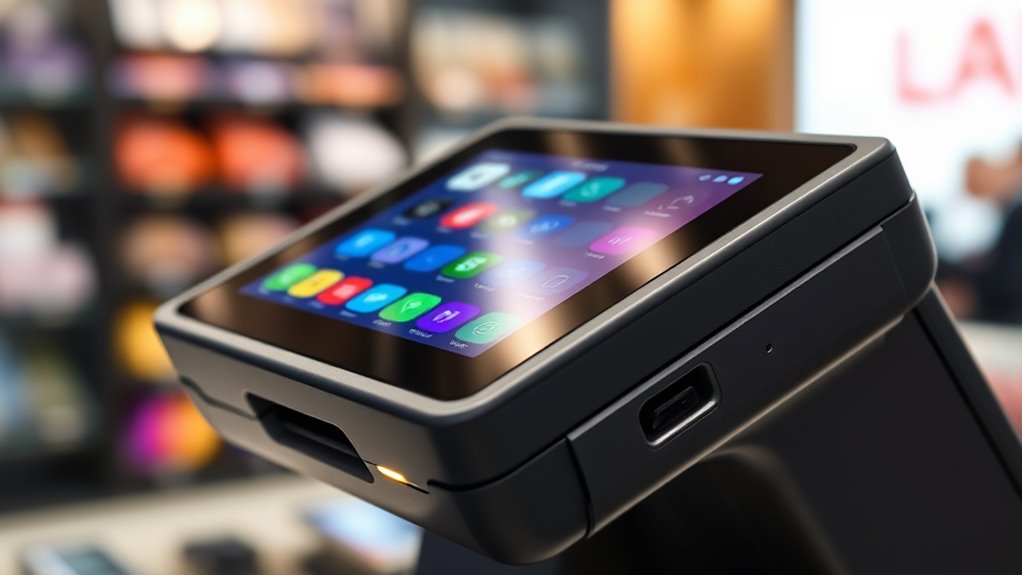Many smart POS terminals have security features you might not be utilizing, like biometric authentication, contactless payment encryption, or real-time monitoring systems. These tools help protect customer data, prevent fraud, and ensure secure transactions. If you’re not leveraging these advanced security options, your system could be more vulnerable than you think. Keep this in mind, because understanding all the available features can make a big difference in safeguarding your business.
Key Takeaways
- Implement biometric authentication like fingerprint or facial recognition for enhanced transaction security.
- Ensure encryption protocols protect sensitive data during contactless transactions and data storage.
- Enable real-time monitoring systems to detect and respond swiftly to suspicious activities.
- Regularly update security firmware and software to defend against evolving cyber threats.
- Utilize secure data communication channels to prevent interception and maintain customer trust.

Smart POS terminals are transforming the way businesses handle transactions by integrating advanced technology into point-of-sale systems. These devices aren’t just about processing payments—they’re about making those payments faster, more secure, and more convenient for both you and your customers. One of the biggest shifts is the rise of contactless payments, which allow your clients to simply tap their cards or smartphones to complete a purchase without fumbling with cash or PINs. This technology not only speeds up checkout times but also reduces contact, making transactions safer, especially in today’s health-conscious environment.
But contactless payments are just part of the security picture. Many smart POS systems now incorporate biometric authentication features, such as fingerprint or facial recognition, to verify identities. If you’re not already using these features, you might be missing out on a significant layer of security. Biometric authentication makes unauthorized access nearly impossible, since it relies on unique physical characteristics rather than passwords or PINs that can be forgotten or stolen. By enabling customers to authenticate payments with a fingerprint or face scan, you reduce the risk of fraud and ensure that transactions are truly authorized by the rightful owner.
These advanced security features often come seamlessly integrated into modern smart POS terminals, so you don’t need to install separate systems or worry about compatibility. When a customer uses contactless payments, the device communicates securely with their card or device, encrypting sensitive data to prevent interception. Combining this with biometric authentication creates a multilayered defense—making it harder for hackers to compromise your system. Plus, biometric data is stored securely within the device or on protected servers, minimizing risks associated with data breaches. Additionally, implementing high-quality encryption protocols enhances overall transaction security and data integrity. Implementing encryption solutions that utilize the latest standards can further strengthen your defenses against cyber threats. Incorporating real-time monitoring systems can also help detect and respond to suspicious activity promptly. Furthermore, staying informed about evolving threats through security updates helps maintain a robust security posture.
A comprehensive approach that includes cybersecurity awareness can help prevent potential breaches and protect both your business and your customers. You should also be aware that these features can enhance customer trust. When clients see you’ve adopted cutting-edge security measures like biometric authentication, they feel more confident in your business. It signals that you’re serious about protecting their data and privacy, which can lead to increased loyalty and repeat business. Furthermore, these security features can streamline the checkout process, reducing wait times and improving overall customer experience.
Incorporating contactless payments and biometric authentication into your smart POS system isn’t just about keeping up with technology; it’s about making transactions safer, faster, and more efficient. If you haven’t explored these features yet, it’s worth considering how they can benefit your business, boost security, and enhance customer satisfaction—all while keeping your payment system ahead of the curve.
Frequently Asked Questions
How Often Should POS Terminals Be Updated for Security?
You should update your POS terminals regularly to stay secure. Software updates should be applied as soon as they’re available to patch vulnerabilities and improve performance. Additionally, keep an eye on hardware replacements; outdated hardware might no longer support necessary security features. Typically, check for updates monthly and plan hardware upgrades every few years. Staying proactive with software updates and hardware replacements helps protect your business from potential security threats.
Are Biometric Authentication Options Available on Smart POS Devices?
Imagine opening your smartphone—biometric integration feels natural, right? Many smart POS devices now offer fingerprint security, making transactions quicker and safer. While not all models include biometric authentication options, some do, providing added layers of protection. If you’re aiming for enhanced security, check if your smart POS supports fingerprint security or other biometric methods. These features could streamline your payment process while keeping sensitive data more secure.
What Are the Best Practices for Securing Transaction Data?
To secure transaction data, you should implement strong encryption protocols that protect information during transmission and storage. Limit user access based on roles, ensuring only authorized personnel handle sensitive data. Regularly update security measures, monitor access logs, and enforce multi-factor authentication. By actively managing encryption and user access controls, you reduce risks of data breaches, keeping transaction information safe and maintaining customer trust.
Can POS Terminals Operate Securely Offline?
Think of your POS terminal as a fortress, even offline. Yes, it can operate securely offline by implementing strong offline security measures like data encryption and secure storage. These features protect transaction data during offline periods, preventing breaches while the system isn’t connected. Just like a fortress, your POS should be fortified with encryption protocols, ensuring that even if offline, your data stays safe from intruders.
How Do I Detect and Prevent POS Malware Attacks?
To detect and prevent POS malware attacks, stay vigilant with threat detection tools that monitor unusual activity on your system. Regularly update your POS software and security patches to close vulnerabilities. Use endpoint security solutions to identify suspicious behavior early. Educate staff about malware risks and phishing attempts. Implement strong access controls, and back up data frequently. These steps help safeguard your POS system against malware and minimize potential damage.
Conclusion
You might think your smart POS terminal is secure enough, but sometimes the most overlooked features are the ones that keep you safe. Coincidentally, it’s often those unnoticed security tools—like encryption or user authentication—that can make all the difference when it counts. So, take a moment to explore your device’s settings; what you don’t activate today could be the safeguard you wish you had tomorrow. After all, security isn’t just about technology—it’s about awareness.










